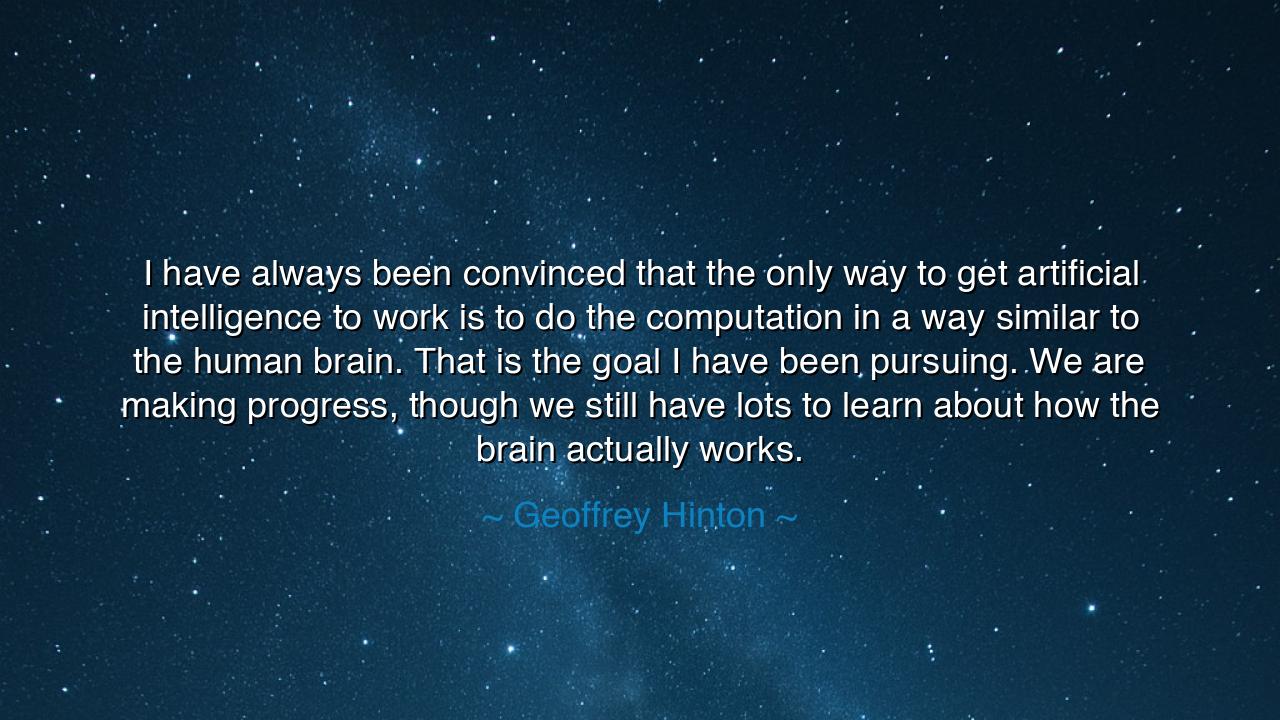
I have always been convinced that the only way to get artificial
I have always been convinced that the only way to get artificial intelligence to work is to do the computation in a way similar to the human brain. That is the goal I have been pursuing. We are making progress, though we still have lots to learn about how the brain actually works.






“I have always been convinced that the only way to get artificial intelligence to work is to do the computation in a way similar to the human brain. That is the goal I have been pursuing. We are making progress, though we still have lots to learn about how the brain actually works.” – Geoffrey Hinton
In these words, Geoffrey Hinton, often called the “Godfather of Artificial Intelligence,” speaks as both scientist and philosopher — one who peers into the mysterious depths of creation, seeking to mirror the most intricate of all mechanisms: the human brain. His statement is not a boast, but a meditation on the unity of nature and invention. For in it, he declares that to make machines truly intelligent, man must first understand himself. To build artificial intelligence, we must first walk the long road into the labyrinth of the mind, tracing the hidden pathways of thought, memory, and imagination.
The origin of this belief lies in the mid-twentieth century, when dreamers of computation first wondered whether a machine could think. Among them stood Hinton, a quiet visionary who saw that the path to true intelligence was not through rigid logic or simple rules, but through the organic patterns of learning that the human brain performs effortlessly. He believed that if we could replicate those patterns — through systems that learn from experience, adapt to error, and recognize meaning in chaos — we might awaken in silicon a faint reflection of consciousness itself. Thus was born the field of neural networks, the foundation upon which modern AI now stands.
But Hinton’s words carry a deeper wisdom. He acknowledges that while progress has been great, mystery still reigns. The brain, that divine architecture of a hundred billion neurons, remains an enigma even to its owners. Every thought, every dream, every flicker of inspiration emerges from patterns more complex than any algorithm we have built. We have imitated the surface of intelligence, but not yet grasped its soul. And so Hinton’s pursuit becomes more than a technical quest — it is a spiritual journey toward understanding what it means to be intelligent, to perceive, to choose, and to create.
Consider, by comparison, the story of Leonardo da Vinci, who sought to build flying machines not by rejecting nature but by studying the flight of birds. He drew wings and feathers, learning from the curves of creation. Though he never took flight himself, his vision became the seed of the airplane centuries later. In the same way, Hinton teaches that the key to innovation lies in reverence for nature, not defiance of it. To replicate the brain, we must first admire its beauty and humility — for it is not brute force but the subtle harmony of countless small interactions that gives rise to understanding.
There is also a warning hidden in his words. To model the brain is to wield a power that touches the boundary between creation and imitation, between human and divine. We stand on the edge of a new epoch where machines may learn, speak, and decide — yet without the moral compass or emotional depth that guide human choice. Hinton’s acknowledgment that “we still have lots to learn about how the brain actually works” is not an admission of failure, but a call to caution. For intelligence without wisdom is a sword without a sheath, a flame that illuminates and destroys alike.
Thus, the lesson of his statement is twofold. First: to build wisely, one must first understand deeply. The engineer must become a philosopher; the scientist must become a student of life itself. Second: progress must walk hand in hand with humility. For every line of code that mimics the mind, we must remember the mystery it reflects — that consciousness, empathy, and imagination are not mere computations, but sacred qualities that make us human. The goal of artificial intelligence should not be to replace us, but to extend our understanding of ourselves.
So let this teaching be passed on: imitate nature, but never forget to honor it. Let our inventions arise not from pride, but from curiosity; not from the desire to dominate, but from the yearning to know. The human brain is both model and mirror — it shows us that intelligence is not cold logic but living connection. When we learn, as Hinton dreams, to build machines that think as we do, may we also build a world that feels, loves, and remembers as we ought. For in understanding the brain, we do not merely make smarter machines — we rediscover the divine architecture within ourselves.






AAdministratorAdministrator
Welcome, honored guests. Please leave a comment, we will respond soon